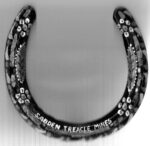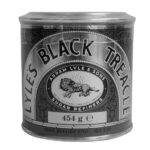Eileen Roche dives into a folklore trope, and recommends ‘suspend disbelief here’
The subject of Treacle Mines has a long and interesting history, which I suspect will be of interest to some NE readers.
I first became aware of their existence when some friends took me for a walk one hot summer’s day on Chobham Common, Surrey, and started to discuss the Treacle Mines to be found there. My astonishment grew as I learned that people first became aware of the mines when treacle began to ooze inexplicably from the ground in the middle of the Common many years ago.
Upon investigation, it transpired that the treacle came from barrels of molasses buried underground by the 8000 troops billeted on the Common prior to embarkation for the Crimean War. I was even shown the area where Queen Victoria had come from Buckingham Palace to review these troops.
During the First World War, the treacle was ‘mined’ to make supplies of sticky bombs and limpet mines, or for filling up vacated trenches to render them unusable. This was fascinating stuff, and I began to research the subject, discovering that there was another story circulating locally as to the origin of the molasses or treacle.
At one time US troops were billeted on the Common, along with their horses, and the molasses were used as horse-fodder, the barrels being buried when they departed about 1919. But the acidity of the soil caused them eventually to burst, and the contents to leak out. A similar tale is told about Surrey Heath, where ‘horse treacle’ is also buried.1
My interest grew further on a visit to Lancashire, when I discovered that there was another Treacle Mine on Pendle Hill. I paid a visit there, to find it situated in Lower House Mill in Sabden, not far from the Pendle Witch pub, and that admission was a mere £1. An enterprising scriptwriter had created a children’s series for TV about Treacle-Miners and their boggart friends and filled the Mill with their stories and characters, all based on the secret Treacle Mines on Pendle Hill. From the publication on sale, The Sabden Treacle Mines Story, I learned that the treacle was ‘now’ used to make fly-paper. In the Treacle Mine Gift Shop, I bought a hand-painted horseshoe as a souvenir.

Gradually, I learned about more Treacle Mines around the country and visited some. One of the better-known is the Treacle Well at Binsey, not far from Oxford. This is dedicated to St. Frideswide, who founded a nunnery here. It lies in the churchyard of St. Margaret of Antioch’s Church. There is a magnificent carving on the wooden pulpit in the church of St. Margaret scaring away a dragon by making the sign of the cross at it. St. Frideswide used to cure the sick with the treacle from her well.
Although it is not a mine, Charles Dodgson (or Lewis Caroll) made it famous when Alice joined the Mad Hatter’s tea party to be told by the Dormouse about the Treacle Well where three little sisters lived, subsisting very well on the treacle and learning to draw it. The author was very familiar with the Binsey well and had taken the original ‘Alice’ to see it. There is another Treacle Well associated with St. Frideswide at Bomy, N France.2 The word ‘treacle’ may have been connected with healing and medicine.3
Newspapers are fond of publishing items about Treacle Mines, such as that at Dunchideock in Devon. The Express and Echo carried an article about it (23 September 1997) when Dunchideock House along with its Treacle Mine was up for sale, explaining that the treacle from the mine was marketed as medicine, glue and love potions. Visitors could see the mine entrance with its barrels of treacle, but for Health and Safety reasons were prevented from entering it, in case they came to a sticky end, related the newspaper. The Western Morning News (24 January 2001) recorded Princess Anne visiting Dunchideock in the rain, when she accepted a special jar of the Dunchideock Treacle from the Treacle Mine Manager.
The West Sussex Gazette (12 July 1973) published a letter from a lady describing a layer of treacle underneath Sussex which came from sugar-cane grown and rotted there before the last Ice Age, accumulating as molasses on a layer of clay; until in 1871 a shaft was sunk into it, causing a gusher to spout for three days, raining treacle over everyone and everything in its vicinity.
The Herefordshire Mercury in 2001 had a letter-writer objecting to a proposal for a new quarry at Wareside, Hertfordshire, on the grounds that it would penetrate a subterranean field of treacle, which could cause a spout of treacle to envelop homes and meadows.
By the late 1990s I had compiled a list of about 50 or so Treacle Mines, many involving boggarts, treacle disasters and increasingly ingenious uses for the treacle. Today, over 70 Treacle Mines are listed at www.treacleminer.com/Mines/Sabden.html, and there are many pubs called The Treacle Mine. There is even a Treacle Mine roundabout on the A13 at its junction with the A1306 near Grays in Essex, named after the adjacent Treacle Mine Inn.
Then in 1997 a little leaflet was brought to my attention by Bob Hanna, from E Sussex: Top Secret File Title: TREACLE P.I.E. This described a newly-created (in 1899) British Secret Underground Army to prepare against outside threats or invasion and they became called Treacle Miners. The title of their organisation was known as Political Intelligence Executive (P.I.E.). Treacle Mining became the cover story to cloak their secret defence activity. They used undercover agents encouraging the spread of treacle-based rumours in local pubs to conceal their activities. 3000 men were eventually underground, training to be ruthless saboteurs, but they were disbanded by 1920. However, the treacle stories and rumours lived on in the minds of local communities. Treacle P.I.E. continued to operate with the formation of a clandestine network of civilian resistance cells. The leaflet contains the amazingly detailed ‘A History of Treacle Mines, a Really Sticky Business (issued to all P.I.E. agents)’, stretching from the Saxons and Romans discovery of Treacle Mines to the present day.

Even the late great fantasy author, Terry Pratchett, wrote about Treacle Mines:4 there was a Treacle Mine road, and sitting in the Treacle Miner pub one of his characters tells a lengthy story from the olden days, when a sudden fall of dark toffee collapsed into the mine tunnels, trapping sixty miners below ground “in a deluge of unrelenting stickiness”. The miners had, with difficulty, to be rescued by their colleagues.
And my conclusions from sharing this information about Treacle Mines and Treacle Mining with NE readers? It’s good to be credulous, isn’t it? As good as being in the (local) know …..
After all, if you are a treacly person, you are too smooth; if you are being treacly, you are too flattering; if you take the treacle stick, you are on the dole; and if you find treacle toffee, that is the railway’s term for coal. I think all this treacle stuff is a very British humour thing. … Or is it?
Notes
- J. Westwood and J. Simpson, Country Lore and Legends. Penguin 2005.
- Chris Catling, ‘Saints and Miracles. The holy well at Binsey’. Current Archaeology 297, Dec. 2014, p22.
- Gary R Varner, in Sacred Wells (Algora, 2009, p155-156) notes a spring in Marlborough, Wilts., at the end of a lane called Treacle Bolley, and that a number of healing wells are known as treacle wells; it may have been that “treacle referred to medicinal substances (a mixture of medicine and molasses)”. ‘Treacle’ well names are often attributed to wells where the flow of water is limited, i.e. ‘trickle well’.
- Terry Pratchett, Raising Steam. Corgi 2014, pp41-43.
Published in NE145, June 2016, pp.13-15
https://northernearth.co.uk/subscription/
